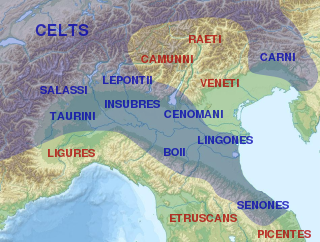Related Research Articles

The Taurini were a Celto-Ligurian tribe dwelling in the upper valley of the river Po, around present-day Turin, during the Iron Age and the Roman period.
The Calucones were a Gallic or Rhaetian tribe dwelling around present-day Chur during the Roman period.

The Alpes Graiae et Poeninae, later known as Alpes Atrectianae et Poeninae, were a small Alpine province of the Roman Empire created after the merging of the Alpes Poeninae and the Alpes Graiae, probably during the reign of Claudius. Comprising the modern Canton of Valais (Switzerland), the Tarantaise Valley (France), and the Val d'Aosta (Italy), it was one of the three provinces straddling the Alps between modern France and Italy, along with the Alpes Maritimae and Alpes Cottiae.
The Alauni were a Gallic tribe dwelling around the lake Chiemsee during the Roman period.
The Marici were a Celto-Ligurian tribe dwelling around present-day Pavia (Lombardy) during the Iron Age.

The Vindelici were a Gallic people dwelling around present-day Augsburg (Bavaria) during the Iron Age and the Roman period.
The Aneuniates were a small Gallic tribe dwelling near Lake Como, around present-day Samolaco, during the Roman period.
The Nemeturii or Nemeturi were a Gallic tribe dwelling in the Alpes Maritimae during the Iron Age.
The Venisami or Venisamores were a Gallic tribe dwelling in the Alps during the Iron Age.
The Ambisontes were a Gallic tribe dwelling in the upper Salzach valley during the Roman period.
The Vennones or Vennonetes were a Rhaetian tribe dwelling in the northern Alps, between Chur and Lake Constance, during the Iron Age and the Roman era.
The Rucinates or Rucantii were a Gallic tribe dwelling in near the confluence of the Isar and Danube rivers during the Roman period.
The Genauni or Genaunes were a Gallic tribe dwelling in the eastern valley of the Inn river, in Tyrol, during the Iron Age and the Roman period.
The Ambilici were a Gallic tribe dwelling in the valley of Gail river during the Roman period.
The Catenates or Cattenates were a Gallic tribe dwelling between the Isar and Inn rivers during the Iron Age.
The Licates were a Gallic tribe dwelling in the upper valley of the Lech river during the Iron Age and the Roman period.
The Ligauni were a Celto-Ligurian tribe dwelling near the Mediterranean coast during the Iron Age and the Roman period.
The Brigantii were a Gallic tribe dwelling southeast of Lake Constance, near present-day Bregenz (Vorarlberg), during the Roman era.
The Brixentes or Brixenetes were a Celtic or Rhaetian tribe living in the Alps during the Iron Age and the Roman era.
The Libicii were a Gallic tribe dwelling in the Camargue region during the Iron Age.
References
- ↑ de Bernardo Stempel 2008, p. 106.
- 1 2 3 4 Frei-Stolba 2002.
- 1 2 Talbert 2000, Map 19: Raetia.
- ↑ Frezouls 1981, p. 241.
Bibliography
- de Bernardo Stempel, Patrizia (2008). "Linguistically Celtic ethnonyms: towards a classification". In García Alonso, Juan Luis (ed.). Celtic and Other Languages in Ancient Europe. Ediciones Universidad de Salamanca. ISBN 978-8478003358.
- Frei-Stolba, Regula (2002). "Bergalei". Historisches Lexikon der Schweiz .
- Frezouls, Edmond (1981). "A propos de la tabula Clesiana". Ktèma. 6 (1): 239–252. doi:10.3406/ktema.1981.1848.
- Talbert, Richard J. A. (2000). Barrington Atlas of the Greek and Roman World. Princeton University Press. ISBN 978-0691031699.
